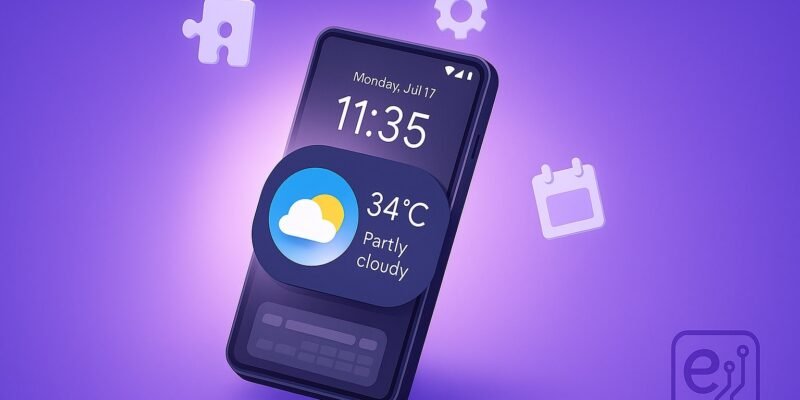Widgets are mini-apps that live on your Android home screen, giving you at-a-glance info or quick access to features—no need to open the full app. Whether you want weather updates, calendar events, music controls, or note-taking tools at your fingertips, widgets make your phone more powerful and personalized.
In this guide, you’ll learn exactly how to add, resize, and configure widgets on most Android devices. By the end, you’ll have a curated home screen that surfaces the content and controls you use most—saving you time and taps every day.
We’ll cover the basics step by step, share pro tips for advanced customization, show you how to use third-party widget tools, and troubleshoot common hiccups so your widgets always work perfectly. Let’s get started!
Step-by-Step Guide
- Unlock your home screen
- From any app or lock screen, press the Home button or gesture to return to your main launcher screens.
- If you’re in a folder, tap outside it to close it.
- Enter widget-selection mode
- Long-press (tap and hold) on any empty area of the home screen.
- In the menu that appears, tap Widgets. On Samsung devices, you may first tap Home screen settings, then Widgets.
- Browse or search for a widget
- Scroll through the alphabetical list of apps with widgets.
- Use the Search widgets bar at the top (if available) to quickly find “Clock,” “Weather,” “Calendar,” etc.
- Choose and place a widget
- Tap and hold the widget you want.
- Drag it to the desired spot on your home screen.
- Release to drop it there.
- Resize the widget
- Long-press the placed widget until a resize frame appears.
- Drag the handles on each side to expand or shrink it.
- Tap outside the widget to confirm the size.
- Configure widget settings
- Many widgets prompt you to select an account or data source (e.g., choose which calendar to display).
- Follow any on-screen setup dialogs.
- To revisit settings later, long-press the widget and tap the ⚙️ or Settings icon if shown.
- Reposition or remove a widget
- To move: long-press and drag it to a new spot or home-screen page.
- To remove: long-press and drag it to Remove or the Trash icon at the top/bottom of the screen.
- Add multiple pages of widgets
- Swipe to an empty home-screen page.
- Repeat the steps above to populate additional pages for different themes—e.g., work widgets on one page, personal on another.
- Lock your home screen layout (optional)
- On many launchers (e.g., One UI, Pixel Launcher), you can lock the layout to prevent accidental moves.
- Go to Home settings and enable Lock home screen layout.
Pro Tips & Workflow Improvements
- Use widget stacks (Android 12+ on Pixel Launcher): stack up to 5 widgets in one spot and swipe through them. Long-press an existing stack and tap Add widget to include more.
- Leverage smart widgets on Android 13+: these change their content based on time of day or location (e.g., showing Today’s Overview in the morning, Smart Reply in messaging apps at other times).
- Try third-party launchers like Nova Launcher for extra control: custom grid sizes, button actions, and even gesture-triggered widgets.
- Download KWGT or Zooper to build fully custom widgets—display data from APIs, battery stats, or fancy animated clocks with zero coding.
- Combine widgets with shortcuts: long-press many widgets let you add tap-and-hold shortcuts (e.g., jump straight to New Email instead of opening inbox).
Advanced Use Case: Automating Widgets with Tasker
If you’re into automation, pair Tasker with plugins like AutoWidget:
- Install Tasker and AutoWidget from the Play Store.
- In Tasker, create a new Task that fetches dynamic info (e.g., current location, next calendar event).
- In AutoWidget, create a widget that displays Tasker variables and configure its update interval.
- Add your AutoWidget to the home screen; it’ll refresh automatically based on your Tasker profile.
This lets you surface virtually any piece of data—live sensor readings, stock prices, smart-home statuses—directly on your launcher.
Troubleshooting & Common Mistakes
- Widget won’t load:
- Ensure the parent app is installed and not disabled (Settings → Apps).
- Check battery-optimization settings; exclude the app from being background-restricted.
- Widget disappears after reboot:
- Lock your home-screen layout.
- Use a launcher known to persist layouts, like Lawnchair or Nova.
- Resizing handles not showing:
- Some widgets have fixed sizes—you can’t resize them.
- Try a different variant (e.g., 4×2 vs. 4×4) in the widget picker.
- Slow widget updates:
- Lower the refresh interval in widget settings.
- Confirm your device isn’t in power-saving mode.
- Overlapping icons/widgets:
- Clear space by moving icons to an app folder first or create an empty home-screen page.
Conclusion
You now know how to add, customize, and troubleshoot widgets on Android—turning your phone’s home screen into a personalized dashboard. Play around with different sizes, stacks, and launchers to find the setup that works best for you.
Ready to go further? Check out our guides on creating custom widgets with KWGT or automating your Android experience using Tasker for the ultimate productivity boost!

